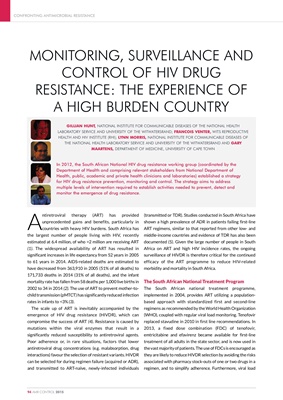
CONFRONTING ANTIMICROBIAL RESISTANCE
94 AMR CONTROL 2015
A
ntiretroviral therapy (ART) has provided
unprecedented gains and benefits, particularly in
countries with a heavy HIV burden. South Africa has
the largest number of people living with HIV, recently
estimated at 6.4 million. Life expectancy has increased from
52 years in 2005 to 61 years in 2014, as a result of
widespread ART access (1). AIDS-related deaths are
estimated to have decreased from 363, 910 deaths in 2005
(51% of all deaths) to 171,733 deaths in 2014 (31% of all
deaths), and the infant mortality rate has fallen from 58
deaths per 1,000 live births in 2002 to 34 infant deaths per
1,000 live births in 2014. Studies from KwaZulu-Natal have
provided estimates of employment recovery among HIV
patients to ~90% of baseline rates observed 3-5 years
before treatment initiation, with many initiating treatments
early enough to avoid any loss of employment.
The scale up of ART is inevitably accompanied by the
emergence of HIV drug resistance (HIVDR). Genetic
mutations within the HIV genome that render a
significantly reduced susceptibility to antiretroviral agents
are easily selected for, given the virus' high replication rate
and error-prone reverse transcription process. With
optimal adherence combination ART can suppress viral
replication for decades. However, sub-optimal adherence or
factors that lower antiretroviral drug concentrations (e.g.
malabsorption, drug interactions) will select for drug
resistant mutants with current generations of
antiretrovirals.
HIVDR can be selected for during regimen failure
(acquired HIVDRA), and transmitted as a drug resistant
strain to a therapy-naïve, newly-infected individual
(transmitted HIVDR). Studies conducted in South Africa
have shown a high prevalence of resistance to one or more
drug classes in patients failing standardized first-line
regimens, similar to that reported from other low- and
middle-income countries (5). Recent evidence further
highlights changes in resistance patterns and specific
mutation rates following treatment guideline changes.
Resistance to protease inhibitors provided as part of
second-line regimens is currently very low. Transmitted
resistance has remained low, but is increasing to moderate
levels (5-15%) to the non-nucleoside reverse transcriptase
inhibitor (NNRTI) drug class in certain regions. In children
infected with HIV despite exposure to antiretroviral drugs
for prevention of mother to child transmission (PMTCT)
transmitted HIVDR is common. It is still unclear what the
significance of this background NNRTI resistance is at a
public health level.
MONITORING, SURVEILLANCE AND
CONTROL IN THE FACE OF HIV
RESISTANCE TO ARV GLOBALLY: THE
EXPERIENCE OF A HIGH-BURDEN
COUNTRY
MALEBONA PRECIOUS MATSOTSO, DIRECTOR-GENERAL, DEPARTMENT OF HEALTH, REPUBLIC OF SOUTH AFRICA
In 2012, the South African National HIV drug resistance working group (coordinated by
the Department of Health and comprising relevant stakeholders from National
Department of Health, public, academic and private health clinicians and laboratories)
established a strategy for HIV drug resistance prevention, monitoring and control. The
strategy aims to address multiple levels of intervention required to establish activities
needed to prevent, detect and monitor the emergence of drug resistance.